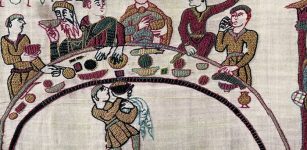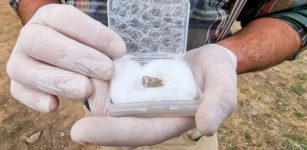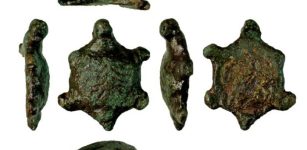Why Was Lovesickness A Feared Disease During The Middle Ages?
Conny Waters - AncientPages.com - Being in love is considered a normal condition today, but this was not the case not so long ago. During the Middle Ages, lovesickness was a feared disease.
 Miniature of a lover and his lady from Christine de Pizan, 'The Book of the Queen' (BL, MS Harley 4431, f. 376: c. 1410-14).
Miniature of a lover and his lady from Christine de Pizan, 'The Book of the Queen' (BL, MS Harley 4431, f. 376: c. 1410-14).
According to Mary Wack, assistant professor of English at Stanford University, lovesickness was a fearsome, sometimes fatal, disease afflicting primarily aristocrats. She defines lovesickness as 'an obsessive fixation on another person.'
Some medieval writings connect lovesickness and bipolar disease—manic symptoms in many accompanied by depressive symptoms of weeping, insomnia, and loss of appetite.
In medieval medicine, the body and soul were closely intertwined – the body, it was thought, could reflect the state of the soul.
During the Middle Ages, doctors believed that the four bodily senses of humor must be perfectly balanced: blood, phlegm, black bile, and yellow bile. Illness was assumed to be caused by disturbances to this balance.
Such ideas were based on the ancient medical texts of physicians like Galen, also known as Galen of Pergamon. Galen was a prominent Greek physician, surgeon, and philosopher in the Roman Empire.
Cupid shoots an arrow in the 'Roman de la Rose'. 14th century. Credit: Wikipedia
Those who have been in love know the meaning of rapid mood swings and depression. It's nothing extraordinary in modern times, but Hippocrates associated such" violent symptoms" with melancholy madness.
It was also believed that only the weakest suffered from lovesickness. The stronger person had more heat power in their eyes and could cause harm to others by looking directly at them.
For example, a woman might see a man she liked and make him ill by looking directly into his eyes. For this reason, love sickness was considered a form of evil eye.
Children of people who suffered from love sickness were also in danger and risked getting the same disease unless they received a good education, excellent discipline, or an orderly lifestyle.
Young children, very old people, eunuchs, and those suffering from impotency were considered essentially immune to the disease.
There were some cures, of course. Women could find a cure in games, food, music, and taking frequent baths. Males who suffered from love sickness were advised to get married or sleep with beautiful women and switch partners as often as possible.
Treatments also included exposure to light, gardens, calm, and rest.
Updated on February 12, 2024
Written by Conny Waters - AncientPages.com Staff Writer
Copyright © AncientPages.com All rights reserved. This material may not be published, broadcast, rewritten or redistributed in whole or part without the express written permission of AncientPages.com
Expand for referencesMore From Ancient Pages
-
 Thales Of Miletus: One Of The Famous “Seven Sages Of Greece” Who Predicted A Solar Eclipse
Featured Stories | Aug 12, 2016
Thales Of Miletus: One Of The Famous “Seven Sages Of Greece” Who Predicted A Solar Eclipse
Featured Stories | Aug 12, 2016 -
 Unicorns In Southern Africa: The Fascinating Story Behind One-Horned Creatures In Rock Art
Featured Stories | Jun 24, 2023
Unicorns In Southern Africa: The Fascinating Story Behind One-Horned Creatures In Rock Art
Featured Stories | Jun 24, 2023 -
 Nomenclator: Ancient Living-Human Calendar And Address Book
Ancient History Facts | Jul 4, 2018
Nomenclator: Ancient Living-Human Calendar And Address Book
Ancient History Facts | Jul 4, 2018 -
 Ancient Egyptian Knowledge Of The Cosmic Engine And Unseen God Of The Universe
Ancient Mysteries | Jan 15, 2019
Ancient Egyptian Knowledge Of The Cosmic Engine And Unseen God Of The Universe
Ancient Mysteries | Jan 15, 2019 -
 Mada’in Saleh: Spectacular Rock-Cut Tombs And Monuments Reflect Great Skills Of Nabataean Builders
Featured Stories | Aug 18, 2020
Mada’in Saleh: Spectacular Rock-Cut Tombs And Monuments Reflect Great Skills Of Nabataean Builders
Featured Stories | Aug 18, 2020 -
 Bayeux Tapestry: Original Location Of Remarkable Romanesque Art – Finally Solved
Archaeology | Oct 26, 2019
Bayeux Tapestry: Original Location Of Remarkable Romanesque Art – Finally Solved
Archaeology | Oct 26, 2019 -
 Mini-Pyramid Discovered In South Saqqara, Egypt
Archaeology | Oct 13, 2017
Mini-Pyramid Discovered In South Saqqara, Egypt
Archaeology | Oct 13, 2017 -
 Ancient Warfare And Continuous Rise In Global Population – Is There A Connection?
Archaeology | Sep 13, 2021
Ancient Warfare And Continuous Rise In Global Population – Is There A Connection?
Archaeology | Sep 13, 2021 -
 Rise Of League Of Mayapán And The Last Great Maya Capital
Featured Stories | Aug 23, 2017
Rise Of League Of Mayapán And The Last Great Maya Capital
Featured Stories | Aug 23, 2017 -
 1.8-Million-Year-Old Human Tooth Found In Georgia Offers More Information On Prehistoric Human Migrations
Archaeology | Sep 15, 2022
1.8-Million-Year-Old Human Tooth Found In Georgia Offers More Information On Prehistoric Human Migrations
Archaeology | Sep 15, 2022 -
 Huge Lost Ancient Underground City Of Samen Finally Reveals Its Secrets
Archaeology | Apr 28, 2017
Huge Lost Ancient Underground City Of Samen Finally Reveals Its Secrets
Archaeology | Apr 28, 2017 -
 Magnificent Burial Chamber Of Idy, Ancient Egyptian Priestess Of Goddess Hathor Discovered In Asyut
Archaeology | Nov 15, 2024
Magnificent Burial Chamber Of Idy, Ancient Egyptian Priestess Of Goddess Hathor Discovered In Asyut
Archaeology | Nov 15, 2024 -
 Massive Fortress Buhen In Ancient Capital Of Egyptian Nubia
Archaeology | Mar 20, 2017
Massive Fortress Buhen In Ancient Capital Of Egyptian Nubia
Archaeology | Mar 20, 2017 -
 On This Day In History: Mount Tambora Volcano Begins A Three-Month-Long Eruption – On Apr 10, 1815
News | Apr 10, 2017
On This Day In History: Mount Tambora Volcano Begins A Three-Month-Long Eruption – On Apr 10, 1815
News | Apr 10, 2017 -
 Rare Ancient Roman Cauldron Discovered In Central Norway
Archaeology | Sep 16, 2019
Rare Ancient Roman Cauldron Discovered In Central Norway
Archaeology | Sep 16, 2019 -
 Neanderthals And Homo Sapiens Invented Different Fire Techniques – Evolution Of Human Cognition
Archaeology | Jun 1, 2023
Neanderthals And Homo Sapiens Invented Different Fire Techniques – Evolution Of Human Cognition
Archaeology | Jun 1, 2023 -
 Anne Neville – The Dramatical Story Of The White Queen
Featured Stories | May 22, 2020
Anne Neville – The Dramatical Story Of The White Queen
Featured Stories | May 22, 2020 -
 Drought Accelerated Hittite Empire Collapse – New Study Suggests
Archaeology | Feb 12, 2023
Drought Accelerated Hittite Empire Collapse – New Study Suggests
Archaeology | Feb 12, 2023 -
 Roman Copper-Alloy Tortoise Figurine Discovered In Suffolk, UK
Archaeology | Dec 4, 2023
Roman Copper-Alloy Tortoise Figurine Discovered In Suffolk, UK
Archaeology | Dec 4, 2023 -
 Over 2,000 Clay Figurines Discovered In The Ancient City Of Kythnos
Archaeology | Jun 10, 2023
Over 2,000 Clay Figurines Discovered In The Ancient City Of Kythnos
Archaeology | Jun 10, 2023

